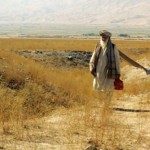Dir. by Atiq Rahimi
Days after his village is destroyed in a bombing raid, Dastaguir (Abdul Ghani) and his five-year-old grandson Yacine (Jawan Mard Homayoun) jump from the back of a pickup truck and take their seats at a desert crossroads, where they wait and wait for a ride to a nearby mine. Dastaguir is charged with the horrifying task of notifying his son that the young man’s wife and mother are dead and that his son, Yacine, is now deaf. Dastaguir is worried for his son’s sanity and is plagued by memories of his daughter-in-law’s shaming, which he was unable to prevent.
As I stepped out of the theater, a woman beside me dismissed Earth and Ashes as an “Afghani Waiting for Godot“; I agree with the description but not the dismissal. Here, unlike Beckett’s play, the absurdity of the situation is grounded in a real historical moment. Earth and Ashes is not only an allegory for some vague existential crisis (though it is certainly also that); instead, the film reveals the human cost of a particular tragedy. By the time Dastaguir recounted the story of his village’s destruction to the fourth stranger, and after hearing yet one more weary soul beg God’s blessings for the dead, I began to experience something of the old man’s exhaustion and helplessness. To be frank, I was embarrassed by it — embarrassed to be sitting in an air conditioned movie theater while on vacation, taking “pleasure” from the suffering depicted on screen. (Doug and I had a great discussion afterwards about film tastes and political sensibilities, but I’ll save that one for another day.)
Earth and Ashes is a jaw-droppingly beautiful film as well, shot on location in wide-angle 35mm (Scope?) and featuring countless elegant crane and tracking shots. In his introduction of the film, Rahimi recounted the risks he and his crew faced by shooting in Afghanistan, particularly because the film features female nudity. The landscape, he claimed, is critical to the story, and I would agree, even extending the concept to the landscapes of Afghani faces, young and old.
Existentialism — to borrow momentarily from my acquaintance’s allusion to Godot — demands that we find some measure of hope in our suffering, that in our acceptance of life’s absurdity we are making some heroic gesture toward freedom. “One must imagine Sisyphus happy,” Camus writes. Rahimi seems driven by a similar conviction. I’m going to cheat and borrow from Doug’s review:
the final sequence of the film is comprised of a gradual focus: a man leaves a conversation, walks through the desert, becomes isolated, begins to sing. The image fades but his singing continues in darkness, a tribute to human dignity and its perseverance through time.
Despite the hectic pace of the film festival, the audience sat quietly for two or three minutes in complete darkness, listening to the old man’s song. It plays like a benediction. Highly Recommended.
